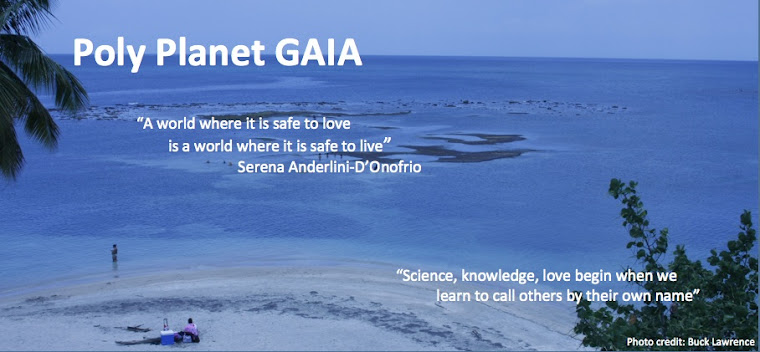Entry: Eros
Serena Anderlini-D’Onofrio,
PhD
1. Summary
The notion of Eros comes from Antiquity. In Greek mythology Eros was the god of
love. Eros represented the marriage of
the sacred and the sexual at the heart of polytheism and classical
mythologies. Knowledge about this deity
was considered good since it involved initiation and training in the arts of
love. Eros was often considered a force
of nature, similar to other Titans or primordial deities. Eros is the topic of Plato's dialog, The Symposium. The Roman version of Eros was Cupid. In the Christian Era, monotheism and the
dogma of "Immaculate Conception" dissolved the marriage of the sacred
and the sexual. In the Early Modern and
Modern Era, Eros made a gradual come back thanks to the Discourse of Love in
Renaissance Poetry and to Freudian Psychoanalysis. In the Post Modern Era, a full come back of
Eros as a supreme force of nature is taking place, as more humans are becoming
aware of love as the ecology of life on the sovereign third planet known as Gaia
or Earth.
2. Introduction
The notion of Eros comes from Antiquity. In Greek mythology, Eros was known as the
deity that represented the cosmic force of love. In most polytheistic cultures, lovemaking was
considered an art. The practice of this
art had a sacred character. Initiation
rituals marked the processes of educating young people into the practice of
these arts. As an element of nature
whose force science could not explain well enough, love had its proper deity
among others in a culture’s pantheon. In
Greek culture, Eros represented both the cosmic force of love and the way this
force was wielded by those trained in the arts of love, or the erotic. The very practice of these arts was
considered sacred, as the energy of love would manifest among deities, among
humans, and between humans and deities.
The binary that opposes love and sex came about when
polytheistic belief systems gave way to various forms of monotheisms, including
Judaism, Christianity, and Islam. With
only one deity to love, legitimate practices of love became narrower. Since the mono deity was typically non-sexualized,
the sacred and the erotic became decoupled, and erotic pleasure became
constructed as “sin” or “vice.” In the
age of European expansion called the Renaissance, Eros was part of the love for
nature--and human nature--that came to the age via Humanism, the cultural
movement that encouraged a genuine study of the classics. Female poets like Veronica Franco and Gaspara
Stampa interpreted the art of love as the source of all other arts. The discourse of love developed across
languages and cultural arenas, including Italy, France, and England. The “flame of love” was a central trope,
carrying the idea of love as an energy that circulates and spreads like
wildfire. The erotic was the background
for the poetic convention of celebrating one’s love life in a sequence of
sonnets, ballads, and madrigals. For the
libertines of the 18th century, the erotic was a subcultural space
to explore various styles of pleasure related to one ideal of the revolution
that concluded the century: liberté! Known leaders in this movement include
Giacomo Casanova and the Marquis de Sade.
In the modern era the notion of Eros was revived when the
human sciences evolved as legitimate disciplines, including sociology,
anthropology, and psychoanalysis. In
this context, Eros became associated with the cultural construct of sexuality. This construct was useful in rescuing erotic
pleasure from the wastebasket of “sin” and “vice” where it had been placed by
institutionalized Christianity. The
notion of “sexuality” placed the arts of love under the aegis of science. It legitimized the study of love and its
practices via the discipline of psychoanalysis, with Freud and others as its
founders. In this essay we will describe
Eros as a cultural construct whose effects are significant in the Ancient and
the modern world. We will focus on how
the trope travels, transforms, adapts across time and cultural landscapes.
To be continued . . . . come back next week, same time.
Sending
much love and all good wishes to all of you and your loved ones.
Thanks you for listening and opening up. Stay tuned for more coming.
With all good wishes for a happy end of winter, spring, and summer.
Thank you!
Namaste,
SerenaGaia
Namaste,
SerenaGaia
Serena Anderlini-D'Onofrio, PhD
Author of Gaia, Eros, and many other books about love Professor of Humanities, University of Puerto Rico, Mayaguez
Poly Planet GAIA Blog: http://polyplanet.blogspot.
Become a Fan: www.facebook.com/GaiaBlessings
Go to Author's Page/Lists all Books:
http://www.amazon.com/-/e/
YouTube Uploaded Videos: http://www.youtube.com/
Be Appraised of Ecosex Community Project PostaHouse









No comments:
Post a Comment